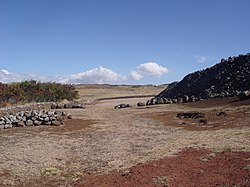Mookini
|
Mookini Heiau
|
|
 |
|
| Nearest city | Hawi, Hawaii |
|---|---|
| Coordinates | 20°15′26″N 155°52′36″W / 20.25722°N 155.87667°WCoordinates: 20°15′26″N 155°52′36″W / 20.25722°N 155.87667°W |
| Area | 116 acres (47 ha) |
| Built | 1370 |
| Architect | Kuamo'o Mo'okini; Paʻao |
| Architectural style | Ancient Hawaiian |
| NRHP reference # | 66000284 |
| Significant dates | |
| Added to NRHP | October 15, 1966 |
| Designated NHL | December 29, 1962 |
Kohala Historical Sites State Monument includes the National Historic Landmark Moʻokini Heiau and the birthplace of Kamehameha I. It is located in remote North Kohala on the Island of Hawaiʻi.
Moʻokini Heiau is one of the oldest historical sites in Hawaiʻi and among its most sacred. Moʻokini means "many lineages" or "many Moʻo" in the Hawaiian Language. Moʻo are large reptile goddesses honored by Hawaiians since before the time of Paʻao.
This heiau is a living spiritual temple and not just an historic artifact of the Hawaiian culture. Oral histories indicate the original temple on the site may be 1500 years old: the genealogy chant of the heiau's kahuna tells of Kuamo'o Mo'okini arriving here in 480, not from Samoa or Tahiti, but from the Persian Gulf of Middle East. Evidence suggests the current temple was built on the site of this smaller older one by Paʻao, who brought the Hawaiian Religion to the islands sometime between 1100 and 1300 A.D.
The current site includes the remains of the heiau measuring 250' x 130' with an open stone paved court enclosed by 20'-high stone walls, and the sacrificial stone. The heiau is constructed of stones that are said to have been passed from hand to hand from the Pololū Valley, over 12 miles (19 km) away. One tradition states that the heiau was completed by the menehune (mythical Hawai'ian little people) in one night.
...
Wikipedia

